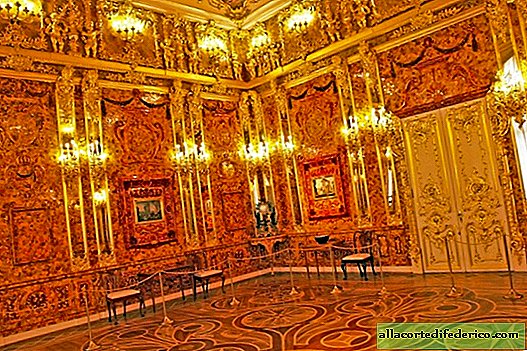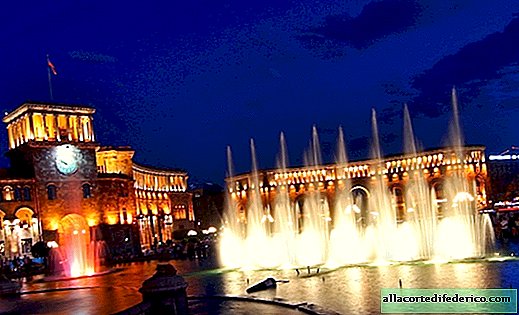The main abduction of the XX century: where the Amber Room disappeared
The disappearance of the Amber Room is perhaps one of the main mysteries of the 20th century. It's no secret that the Amber Room, exhibited today in the Catherine Palace is just a copy, although as close as possible to the original. But the fate of this Amber Room, the very one that was presented to the Russian Emperor Peter I, is shrouded in mystery. Since she was abducted during the Second World War and taken outside Russia, almost nothing is known about her fate.
 Copy of the Amber Room in the Catherine Palace
Copy of the Amber Room in the Catherine PalaceInitially, an amber masterpiece was made in 1709 for the Prussian King Frederick I, but then his son presented this cabinet to the Russian Emperor Peter I. In 1717, amber panels were delivered to Russia and installed in one of the halls in the Summer Garden of St. Petersburg.
Later, the daughter of Peter I, Empress Elizabeth Petrovna decided to transform the Amber Cabinet, making it larger and more luxurious. Under the direction of F. B. Rastrelli, mirrors, mosaic panels and other decorative elements appeared in the decoration of the amber office. As a result of the reconstruction, the office was called the "Amber Room", as it significantly increased in size and was complemented by luxurious details. The amber room from the end of the 18th century was located in the summer residence of Russian emperors - in the Catherine Palace of Tsarskoye Selo (modern city of Pushkin).
 Photograph of a genuine Amber Room in the Catherine Palace, 1911
Photograph of a genuine Amber Room in the Catherine Palace, 1911As a result of the invasion of Nazi troops, the Catherine Palace was in the occupied territories. Today it is difficult to say why the Amber Room was not taken out for evacuation, as was done, for example, with other masterpieces of the Catherine Palace. According to one version, when museum staff began to dismantle the room, fragile amber panels began to crumble, so it was decided to leave it in place, previously protecting it from the effects of the bombing.
According to surviving evidence, after the Nazis captured the Catherine Palace, the Amber Room was dismantled by German soldiers in just 36 hours and taken to Königsberg (the modern Russian city of Kaliningrad). From 1942 to 1944, the Amber Room was exhibited in the Royal Castle of Königsberg. According to the researchers, the room where the "heritage of the German nation" was demonstrated, as the Amber Room was called, was smaller than the hall in which it was installed earlier. For this reason, some of the panels were then stored separately. In 1944, when the Allied forces launched air attacks on the city, the Amber Room was again dismantled and it was stored in the cellars of the castle. During the storming of the city by Soviet troops, the Amber Room disappeared, and its traces were lost forever.
 Amber Room Fragment
Amber Room FragmentAs it turned out later, the disappearance of part of the Amber Room occurred during its removal by the German army from Russia. One of the German officers who participated in the sacking of the Catherine Palace took a part of the amber masterpiece with him, which was quite expected under wartime conditions. One of the Florentine mosaics unexpectedly showed up in 1997, when they tried to sell it. As a result of lengthy proceedings, the mosaic was in the ownership of the city of Bremen, which handed it along with the amber chest of drawers to Tsarskoye Selo Museum.
Researchers state several versions about the location of the Amber Room. It could burn out during the bombing of Königsberg (this version was considered a priority for a long time after the transfer of Königsberg to the Soviet state), and it could be taken to German territory, where its traces in the conditions of the retreat of the German army and the confusion of the last months of the war cannot be traced.
 Fragment of the restored Amber Room
Fragment of the restored Amber RoomThe researchers got into the correspondence of the director of the Prussian Museum, which exhibited the "heritage of the German nation", Dr. Alfred Rode and Adolf Hitler. At the end of 1944, the Führer demanded that the Amber Room be delivered to Berlin, to which Dr. Rode replied that the panels were hidden in a secure bunker, and the dispatch might be unsafe. But extensive searches in the territory of Kaliningrad and the entire region did not yield any results. According to the results of numerous not only Soviet, but also international investigations on the search for the Amber Room, it is concluded that the room can be located anywhere - from secret burials in Europe, to private collections of art lovers in the USA.
In 2003, work was completed to create an exact copy of the Amber Room, which you can admire in the Catherine Palace. But a copy is a copy, and the fate of the genuine Amber Room still excites the minds of historians, forensic scientists, journalists, politicians and public figures. This detective story haunts more than one generation of researchers. Despite the fact that fragments of a genuine amber masterpiece periodically pop up in different parts of the world, its fate is still unknown.
 Museum Visitors in the Restored Amber Room
Museum Visitors in the Restored Amber Room

















